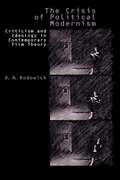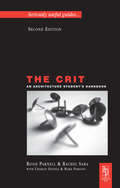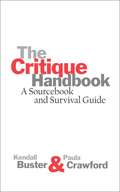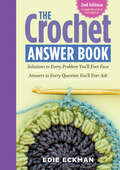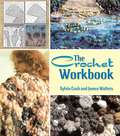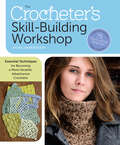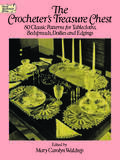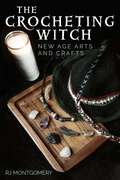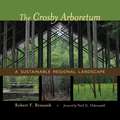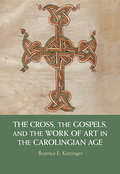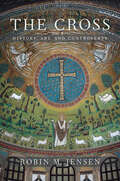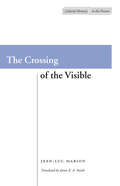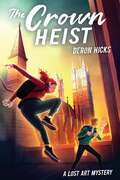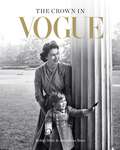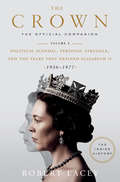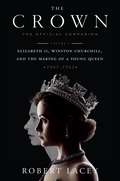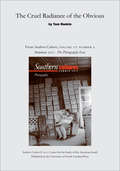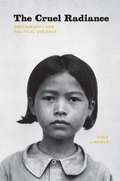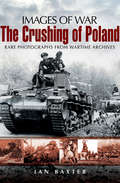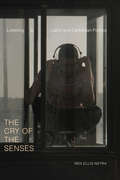- Table View
- List View
The Crisis of Political Modernism: Criticism and Ideology in Contemporary Film Criticism
by D. N. RodowickD.N. Rodowick offers a critical analysis of the development of film theory since 1968. He shows how debates concerning the literary principles of modernism—semiotics, structuralism, psychoanalysis, Marxism, and feminism—have transformed our understanding of cinematic meaning. Rodowick explores the literary paradigms established in France during the late 1960s and traces their influence on the work of diverse filmmaker/theorists including Jean-Luc Godard, Peter Gidal, Laura Mulvey, and Peter Wollen. By exploring the "new French feminisms" of Irigaray and Kristeva, he investigates the relation of political modernism to psychoanalysis and theories of sexual difference. In a new introduction written especially for this edition, Rodowick considers the continuing legacy of this theoretical tradition in relation to the emergence of cultural studies approaches to film.
The Crit: An Architecture Student's Handbook
by Rachel Sara Charles Doidge Rosie ParnellThe architectural crit, review or jury is a cornerstone of architectural education around the world. The defence of ideas, drawings, and models in an open format before staff and peers is intended to be a foreground for healthy creative debate, but many students view it as hostile confrontation – an ego trip for staff and humiliation for them. This accessible and immensely enjoyable book guides students through this academic minefield.This fully updated edition includes advice and suggestions for tutors on how to model a crit around a broad range of learning styles, as well as a new section aimed at students with learning disabilities, to ensure that the process is constructive and beneficial for all architecture and design scholars. Packed with practical tips from tutors, students and professionals, this reassuringly honest book will prepare students to build more creative relationships with clients and users across the industry. Also in the Seriously Useful Guides series:* Practical Experience* The Dissertation* The Portfolio
The Critical Eye: An Introduction to Looking at Movies (3rd revised edition)
by Margo Kasdan Christine Saxton Susan TavernettiAn excellent summary and profound analysis of the techniques and interpretation of movies.
The Critique Handbook: A Sourcebook and Survival Guide
by Kendall Buster Paula CrawfordBenefiting all visual artists regardless of their level of expertise, this book enables reader to deal with the important instructional studio classroom activity of critiquing art works.
The Crochet Answer Book, 2nd Edition: Solutions to Every Problem You'll Ever Face; Answers to Every Question You'll Ever Ask
by Edie EckmanEdie Eckman’s classic Q&A reference book has been updated with helpful answers to even more of your burning crochet questions. From beginning basics like yarn styles, stitch types, and necessary tools to detailed outlines of more advanced techniques, you can trust Eckman to deliver straightforward guidance and plenty of encouragement. With illustrations for left-handed crocheters and tips for broomstick lace, linked stitches, crochet cables, and more, The Crochet Answer Book is full of expert advice on every page.
The Crochet Workbook
by James Walters Sylvia CoshTake your craft to another level with this imaginative approach to crochet. More than just a manual on techniques or a pattern book, this guide shows how to transcend the use of traditional hooks, stitches, and yarns to produce truly innovative creations. A pioneering work in freeform crochet, the book is suitable for all ages and levels of expertise. It provides beginners with the chance to master basic stitches, and it offers advanced crocheters the opportunity to discover new ideas, colors, and designs.More than 80 color photographs and 49 line drawings with captions illustrate everything from stitches to garment construction to finished products. A concluding section of practical information explains abbreviations and terms, and every chapter encourages the development of personal creativity and individual style.
The Crocheter's Companion: Revised and Updated (Companion, The Ser.)
by Nancy BrownExplore a guidebook with over 65,000 copies sold! Get more stitches, over 70 new illustrations, and step-by-step techniques in this new edition of The Crocheter's Companion. This indispensable resource includes all of the essentials, plus a few exciting extras you've been longing for: more tools, stitches, and techniques, as well as updated yarn information, complete abbreviations and symbols, and additional information on reading stitch diagrams. Also, due to popular demand, the section on Tunisian crochet has been expanded. Still in its handy pocket-sized, spiral-bound format, the updated edition covers all the basics (and then some!). Thread and hook charts, stitch instructions with clear illustrations, and lots of helpful hints from one of crochet's most experienced authors will inspire beginners and serious crocheters alike. With impeccable illustrations, an easy-to-understand format, and the most updated information available, The Crocheter's Companion will soon become the only crochet resource you'll need.
The Crocheter's Skill-Building Workshop: Essential Techniques for Becoming a More Versatile, Adventurous Crocheter
by Dora OhrensteinFrom choosing yarns, shapes, and styles to finishing off your project with flair, Dora Ohrenstein shows you how take your crocheted creations to the next level. This fun guide includes more than 70 stitch-along swatches that teach specific crochet techniques and five projects — a hat, shawl, neck warmer, bag, and scarf — that put your new skills to use. With a variety of stitch patterns and shaping types explained, you’ll be inspired to build upon Ohrenstein’s creations and develop your own sophisticated designs.
The Crocheter's Treasure Chest: 80 Classic Patterns for Tablecloths, Bedspreads, Doilies and Edgings
by Mary Carolyn WaldrepBeautiful crocheted items that enhanced interior furnishing generations ago are once again in the needlecraft spotlight. For this outstanding collection of classic crochet patterns, needlework authority Mary Carolyn Waldrep has selected for today's needleworker a variety of attractive designs that first appeared in now-rare thread-company instruction leaflets of the 1930s through the '50s.Included in The Crocheter's Treasure Chest are patterns for a lovely tablecloth with a rose motif, a floral-patterned refreshment set (comprising coasters and a larger doily), an elegant series of wide edgings displaying scallops, florals, and filet mesh; a tea-cart cloth with lacy petal designs; a magnificent "Cameo" bedspread; the "Chrysanthemum," a charming tablecloth composed of delicate medallions beautiful enough to complement any table arrangement; and dozens of other eye-catching pieces.A complete list of necessary materials accompanies each pattern, while more than 65 illustrations and detailed, row-by-row instructions guide beginning and advanced needleworkers through each step of the crocheting process. Here's a rich anthology of heirloom-quality designs that crocheters are sure to find inspirational and irresistible.
The Crocheting Witch: New Age Arts and Crafts
by RJ MontgomeryA Craft and Crochet Book for New Age Readers, Wiccans, and Neopagans to Assist with Spells and Spell-Work Many students of New Age beliefs, from Wicca to Neopaganism, create items to assist with their work by managing energy and controlling spells. These homemade, hand-crafted materials have personal significance, beauty, and practical, useful effects. A quick reference for people specifically looking to incorporate crochet into their craft, The Crocheting Witch is a guide to using different types of stitch pattern, materials, herbal and essential-oil infusions, beads, and charms to create a variety of crocheted crafts: Wand casesTarot boxCandle cozyCrystal-storage amuletAnd many more!The Crocheting Witch teaches readers—from fans of New Age practices, to Wiccans, to Neopagans—to create items themselves to control energies and channel them for personal use.
The Crosby Arboretum: A Sustainable Regional Landscape (Reading the American Landscape)
by Robert F. Brzuszek Neil G. OdenwaldSince its genesis in 1980, Crosby Arboretum in southern Mississippi has attracted international recognition for its contributions to architecture, biology, and landscape design. Now owned and operated by Mississippi State University, Crosby is the first fully realized ecologically designed arboretum in the United States and the premier native plant conservatory in the Southeast.Former site director and curator Robert F. Brzuszek provides a detailed survey of the arboretum's origins, planning, construction, and ongoing management. More than just a botanical center, Crosby emerged as one of the first American landscape projects to successfully balance natural habitat and planned design. The book's generous selection of photographs and drawings illustrate the beauty and purpose of the site's components: the award-winning Pinecote Pavilion, designed by architect Fay Jones; a 104-acre focus area that includes the Piney Woods Lake, which displays native water plants in their natural setting; and seven hundred additional acres of savanna, woodland, and aquatic environments that nurture more than 300 species of indigenous trees, shrubs, wildflowers, and grasses. Utilizing the interactions between two opposing natural forces -- fire and water -- Crosby Arboretum protects the biological diversity indigenous to the Pearl River Drainage Basin, in southern Mississippi and southeastern Louisiana. Brzuszek's inspiring and informative account will help further Crosby's role as a model of sustainable landscape design and management across the country.
The Cross, the Gospels, and the Work of Art in the Carolingian Age
by Beatrice E. KitzingerIn this book, Beatrice E. Kitzinger explores the power of representation in the Carolingian period, demonstrating how images were used to assert the value and efficacy of art works. She focuses on the cross, Christianity's central sign, which simultaneously commemorates sacred history, functions in the present, and prepares for the end of time. It is well recognized that the visual attributes of the cross were designed to communicate its theology relative to history and eschatology; Kitzinger argues that early medieval artists also developed a formal language to articulate its efficacious powers in the present day. Defined through form and text as the sign of the present, the image of the cross articulated the instrumentality of religious objects and built spaces. Whereas medieval and modern scholars have pondered the theological problems posed by representation, Kitzinger here proposes a visual argument that affirms the self-reflexive value of art works in the early medieval West. Introducing little-known sources, she re-evaluates both the image of the cross and the project of book-making in an expanded field of Carolingian painting.
The Cross: History, Art, and Controversy
by Robin M. JensenThe cross stirs intense feelings among Christians and non-Christians alike. Robin Jensen takes readers on an intellectual and spiritual journey through the 2,000-year evolution of the cross as idea and artifact, illuminating the controversies and forms of devotion this central symbol of Christianity inspires.
The Cross: History, Art, and Controversy
by Robin M. Jensen&“This erudite history illuminates the social, cultural, as well as theological developments of the cross&” through 2000 years of its symbolic evolution (Library Journal). Jesus&’s death on the cross posed a dilemma for Saint Paul and the early Church fathers. Crucifixion was a humiliating form of execution reserved for slaves and criminals. How could their messiah and savior have been subjected to such an ignominious death? Wrestling with this paradox, they reimagined the cross as a triumphant expression of Christ&’s sacrificial love and miraculous resurrection. Over time, the symbol&’s transformation raised myriad doctrinal questions, particularly about the crucifix―the cross with the figure of Christ―and whether it should emphasize Jesus&’s suffering or his glorification. How should Jesus&’s body be depicted: alive or dead, naked or dressed? Should it be shown at all? Robin Jensen&’s wide-ranging study focuses on the cross in painting and literature, the quest for the &“true cross&” in Jerusalem, and the symbol&’s role in conflicts from the Crusades to wars of colonial conquest. The Cross also reveals how Jews and Muslims viewed the most sacred of all Christian emblems and explains its role in public life in the West today.
The Crossing Point: Selected Talks and Writings
by Mary Caroline RichardsA stunning example of poetic questioning.
The Crossing of the Visible
by James Smith Jean-Luc MarionPainting, according to Jean-Luc Marion, is a central topic of concern for philosophy, particularly phenomenology. For the question of painting is, at its heart, a question of visibility--of appearance. As such, the painting is a privileged case of the phenomenon; the painting becomes an index for investigating the conditions of appearance--or what Marion describes as "phenomenality" in general. In The Crossing of the Visible, Marion takes up just such a project. The natural outgrowth of his earlier reflections on icons, these four studies carefully consider the history of painting--from classical to contemporary--as a fund for phenomenological reflection on the conditions of (in)visibility. Ranging across artists from Raphael to Rothko, Caravaggio to Pollock, The Crossing of the Visible offers both a critique of contemporary accounts of the visual and a constructive alternative. According to Marion, the proper response to the "nihilism" of postmodernity is not iconoclasm, but rather a radically iconic account of the visual and the arts that opens them to the invisible.
The Crown Heist (The Lost Art Mysteries)
by Deron R. HicksIn another "suspenseful mystery romp with art appreciation" (Kirkus Reviews, starred review), Art and Camille head to London to find her estranged father, and soon find themselves embroiled in a heist involving a long-dead monarch. Packed with fascinating facts about real places and pieces of art, this fast-paced thriller is perfect for fans of the Spy School and Mr. Limoncello's Library series and Dan Brown.No matter how dangerous his adventures have been, Art has always been able to count on his best friend, Camille. Now that Camille is meeting her estranged father, Art wants to be there for her—which means going to London. But Camille's history professor father, renowned for expertise in British legend, is missing. When they visit his apartment, Art and Camille find a long-missing object that suggests the professor could be in trouble and solving a mystery related to London's history. Follow Art and Camille as they visit the Tower of London, National Portrait Gallery, and ride the "tube" in hopes of uncovering the truth before it's too late.
The Crown in Vogue: Vogue's 'special royal salute' to Queen Elizabeth II and the House of Windsor
by Josephine Ross Robin MuirA lavishly illustrated celebration of the 70-year reign of Queen Elizabeth II and the British Royal Family from the unrivalled archive of British Vogue.'Vogue, like the royal family, has been through many evolutions of its own, and to view Her Majesty's life though the record of our pages is truly a document of history.' - Edward Enninful, Editor-in-Chief of British VogueFour monarchs (crowned and uncrowned); one abdication; one royal investiture; a jewel box of jubilees and many, many royal marriages... British Vogue has borne witness to a century of royal history. The Crown in Vogue is the magazine's 'special royal salute' to our longest serving monarch and her 'assured and unwavering' presence in the lives of a nation.Vogue's first star photographer, Cecil Beaton, was entranced by the House of Windsor and the admiration was mutual. A younger star photographer, Antony Armstrong Jones, left Vogue to marry the Queen's sister and returned as Lord Snowdon. The Queen's cousin, Vogue's Lord Lichfield proved an insightful photographer of royal style along with many of Vogue's fashion photographers including Horst, Norman Parkinson and David Bailey. With visual treasures from Vogue's unrivalled archive and contributions through the decades from the most perceptive of royal commentators - from Evelyn Waugh to Zadie Smith - The Crown in Vogue is the definitive, authoritative portrait of Queen Elizabeth II's magnificent reign - and of royalty in the modern age.
The Crown in Vogue: Vogue's 'special royal salute' to Queen Elizabeth II and the House of Windsor
by Josephine Ross Robin MuirA lavishly illustrated celebration of the 70-year reign of Queen Elizabeth II and the British Royal Family from the unrivalled archive of British Vogue.'Vogue, like the royal family, has been through many evolutions of its own, and to view Her Majesty's life though the record of our pages is truly a document of history.' - Edward Enninful, Editor-in-Chief of British VogueFour monarchs (crowned and uncrowned); one abdication; one royal investiture; a jewel box of jubilees and many, many royal marriages... British Vogue has borne witness to a century of royal history. The Crown in Vogue is the magazine's 'special royal salute' to our longest serving monarch and her 'assured and unwavering' presence in the lives of a nation.Vogue's first star photographer, Cecil Beaton, was entranced by the House of Windsor and the admiration was mutual. A younger star photographer, Antony Armstrong Jones, left Vogue to marry the Queen's sister and returned as Lord Snowdon. The Queen's cousin, Vogue's Lord Lichfield proved an insightful photographer of royal style along with many of Vogue's fashion photographers including Horst, Norman Parkinson and David Bailey. With visual treasures from Vogue's unrivalled archive and contributions through the decades from the most perceptive of royal commentators - from Evelyn Waugh to Zadie Smith - The Crown in Vogue is the definitive, authoritative portrait of Queen Elizabeth II's magnificent reign - and of royalty in the modern age.
The Crown: Political Scandal, Personal Struggle, and the Years that Defined Elizabeth II (1956-1977) (The Crown #2)
by Robert LaceyThe fascinating royal and social history that inspired seasons 2 and 3 of The Crown, written by the show&’s historical consultant. In this eye-opening companion to seasons 2 and 3 of Netflix&’s acclaimed series The Crown, renowned biographer—and the show&’s historical consultant—Robert Lacey takes us through the real history that inspired the drama. Covering two tumultuous decades in the reign of Queen Elizabeth II, Lacey looks at the key social, political, and personal moments and their effects—not only on the royal family but also on the world around them. From the Suez Crisis and the U.S.–Soviet space race to the legacy of the Duke of Windsor&’s collaboration with Hitler, along with the rumored issues with the royal marriage, the book provides a thought-provoking insight into the historic decades that the show explores, revealing the truth behind the on-screen drama. Extensively researched and complete with beautifully reproduced photographs, this is a unique look behind the history that inspired the show and the years that would prove to be the making of the Queen.The Crown is now available to watch on Netflix.The Crown is produced by Left Bank Pictures in association with Sony Pictures Television for Netflix.
The Crown: The Official Companion, Volume 1: Elizabeth II, Winston Churchill, and the Making of a Young Queen (1947-1955) (The Crown #1)
by Robert LaceyThe official companion to the Emmy-winning Netflix drama chronicling the reign of Queen Elizabeth II, and starring Claire Foy and John Lithgow, The Crown by Peter Morgan, featuring additional historical background and beautifully reproduced archival photos and show stills <P><P>Elizabeth Mountbatten never expected her father to die so suddenly, so young, leaving her with a throne to fill and a global institution to govern. <P>Crowned at twenty-five, she was already a wife and mother as she began her journey towards becoming a queen. <P> As Britain lifted itself out of the shadow of war, the new monarch faced her own challenges. <P>Her mother doubted her marriage; her uncle-in-exile derided her abilities; her husband resented the sacrifice of his career and family name; and her rebellious sister embarked on a love affair that threatened the centuries-old links between the Church and the Crown. <P>This is the story of how Elizabeth II drew on every ounce of resolve to ensure that the Crown always came out on top. <P>Written by the show’s historical consultant, royal biographer Robert Lacey, and filled with beautifully reproduced archival photos and show stills, The Crown: The Official Companion: Volume 1 adds expert and in-depth detail to the events of the series, painting an intimate portrait of life inside Buckingham Palace and 10 Downing Street. <P>Here is Elizabeth II as we’ve never seen her before.
The Cruel Radiance of the Obvious
by Tom RankinThis introductory essay uses William Eggleston as the point of entry to preview the entire photography issue and includes striking photographs from Ansel Adams, Walker Evans, Dorothea Lange, and Susan Harbage Page—as well as exploring the stunning work of Paul Kwilecki. "Photography in its finest and most decisive moments is about those tired or ignored or unseen parts of our lives, the mundane and worn paths that sit before us so firmly that we cease to notice. It is, we might say, about rebuilding our sight in the face of blindness, of recovering our collective vision." This article appears in the Summer 2011 issue of Southern Cultures: The Photography Issue.
The Cruel Radiance: Photography and Political Violence
by Susie LinfieldIn The Cruel Radiance, Susie Linfield challenges the idea that photographs of political violence exploit their subjects and pander to the voyeuristic tendencies of their viewers. Instead she argues passionately that looking at such images—and learning to see the people in them—is an ethically and politically necessary act that connects us to our modern history of violence and probes the human capacity for cruelty. Grappling with critics from Walter Benjamin and Bertolt Brecht to Susan Sontag and the postmoderns—and analyzing photographs from such events as the Holocaust, China’s Cultural Revolution, and recent terrorist acts—Linfield explores the complex connection between photojournalism and the rise of human rights ideals. In the book’s concluding section, she examines the indispensable work of Robert Capa, James Nachtwey, and Gilles Peress and asks how photography should respond to the increasingly nihilistic trajectory of modern warfare.A bracing and unsettling book, The Cruel Radiance convincingly demonstrates that if we hope to alleviate political violence, we must first truly understand it—and to do that, we must begin to look.
The Crushing of Poland: Rare Photographs from Wartime Archives (Images of War)
by Ian Baxter"Hitlers decision to invade Poland in August 1939 triggered the start of the Second World War. It was also the first demonstration of Blitzkrieg tactics the ruthless use of armor, mobile infantry and air support. The brave Polish army, inadequately equipped and inferior in numbers, was overwhelmed by this awesome display of military power as well as being taken by surprise. Official German photographers accompanied the triumphant Nazi forces on their victorious advance which first seized the key part of Danzig and then Warsaw, all within one month. The Crushing of Poland captures the drama and raw aggression of the Campaign in photographs and full captions."
The Cry of the Senses: Listening to Latinx and Caribbean Poetics (Dissident Acts)
by Ren Ellis NeyraIn The Cry of the Senses, Ren Ellis Neyra examines the imaginative possibility for sound and poetics to foster new modes of sensorial solidarity in the Caribbean Americas. Weaving together the black radical tradition with Caribbean and Latinx performance, cinema, music, and literature, Ellis Neyra highlights the ways Latinx and Caribbean sonic practices challenge antiblack, colonial, post-Enlightenment, and humanist epistemologies. They locate and address the sonic in its myriad manifestations—across genres and forms, in a legal trial, and in the art and writing of Xandra Ibarra, the Fania All-Stars, Beatriz Santiago Muñoz, Édouard Glissant, and Eduardo Corral—while demonstrating how it operates as a raucous form of diasporic dissent and connectivity. Throughout, Ellis Neyra emphasizes Caribbean and Latinx sensorial practices while attuning readers to the many forms of blackness and queerness. Tracking the sonic through their method of multisensorial, poetic listening, Ellis Neyra shows how attending to the senses can inspire alternate, ethical ways of collective listening and being.
